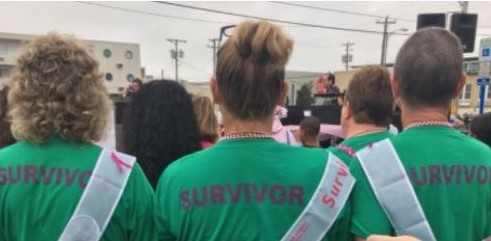By Guest Blogger Amy Hughes
My great grandmother died of ovarian cancer at just 39 years old. Her daughter, my paternal grandmother was diagnosed at 39 with breast cancer, and died before her 50th birthday. Two of her daughters, my aunts are currently in remission from breast cancer. So many cancer diagnosis left our whole family asking how could so many women in our family have the same cancer at such young ages? From my aunt’s family history, her doctor recognized the need for genetic testing for an inherited genetic mutation called BRCA, the BReast CAncer gene.
In 1990 Dr. Mary Claire King discovered the breast cancer gene BRCA 1 and it’s sister genetic mutation BRCA 2. These inherited genetic mutations can lead to breast and ovarian cancer in women, and breast and prostate cancer in men. Carriers of the BRCA gene have an 85% chance of getting breast or ovarian cancer, as opposed to a 13% chance in patients without BRCA.
So what is an inherited genetic mutation? In layman’s terms, your whole body is made up of DNA strands, which are the building blocks of your body. They determine everything from your eye color to the shape of your toes. An inherited genetic mutation is an abnormality in your DNA strands that changes how they are built and is passed down from one family member to the next. When this mutation increases the likelihood you will have an early age cancer diagnosis, this is called Family Cancer Syndrome. HBOC (Hereditary Breast and Ovarian Cancer) is the family cancer syndrome caused by the BRCA gene mutation.
HBOC is not the only family cancer syndrome out there. Lynch Syndrome increases the risk of colorectal cancer. Cowden syndrome can cause an array of problems including polyps that can become cancerous. Li-Fraumeni syndrome causes a higher risk to more uncommon cancers such as certain types of sarcomas.

According to the American Cancer Society there are certain things you can look for in your family tree to determine if you may be at risk for Family Cancer Syndrome.
- Many cases of the same type of cancer (especially if it is an uncommon or rare type of cancer)
- Cancers occurring at younger ages than usual (like colon cancer in a 20-year-old)
- More than one type of cancer in a single person (like a woman with both breast and ovarian cancer)
- Cancers occurring in both of a pair of organs (like both eyes, both kidneys, or both breasts)
- More than one childhood cancer in siblings (like sarcoma in both a brother and a sister)
- Cancer occurring in the sex not usually affected (like breast cancer in a man)
- Cancer occurring in many generations (like in a grandfather, father, and son)
If you think you may be at risk for family cancer syndrome the best first step you can take is to see a genetic counselor. A genetic counselor can not only test you for abnormalities, but can also create a family tree for you with your family’s cancer history. This family tree is helpful not only for you, but also for future generations who may need to be tested.

Thanks to our genetic family tree, my cousin and I, who were both diagnosed with HBOC, were able to take the first steps in preventing breast cancer. And hopefully neither one of us will be fighting the battle so many women face, anytime soon.
Want to see more blogs like this and get notifications on local events and happenings? Subscribe to Triad Moms on Main’s free weekly newsletters here.
















